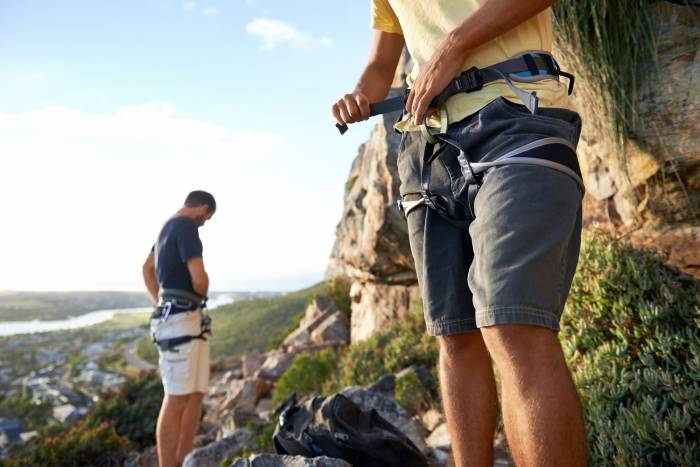It all started with a simple question: What car should I buy to accommodate the big, bulky crash pads I need for bouldering?
That’s what Warner Krause, a climber and engineer, asked himself in 2019 when buying a vehicle. He’d been bouldering since 2015 and knew he wanted plenty of space. He ultimately decided on a Subaru Crosstrek, which could fit two crash pads, climbing gear, and perhaps some friends.
“It’s absurd to make a thousands-dollar decision based on the size of crash pads,” Krause told GearJunkie on Thursday.
Now, Krause thinks he has designed the solution: an inflatable crash pad that weighs just 3.5 pounds (instead of the 10-20 pounds of most modern options). It measures 48 by 36 by 6 inches, inflates in less than a minute, and folds up so small you could squeeze five of them into a normal backpack.
Krause launched a Kickstarter this week for what he’s calling the Sick Sequence Crash Pad. With bouldering now the fastest-growing segment of climbing, there’s certainly an audience for this glaring design issue in conventional pads. But, will it meet the demands of rock hounds?

A Tough Design
Anyone who has hauled a traditional crash pad across rocky terrain will intuitively understand the issue Krause hopes to address. When he started bouldering 8 years ago, he saw the problem immediately.
“It just never made sense to me that we carried this huge, cumbersome pad on our backs,” he said in an interview Thursday. “If you have somebody who’s not a climber, and you see the look that they give you, like ‘What are you doing?’ — then you know what I’m talking about.”
But, solving the design challenge of a lightweight crash pad proved difficult. You can’t just grab an inflatable mattress and use that instead. They’re not durable enough to resist the punishment of climbers crashing down on top of it over and over again.
Krause, who started working on his design at the beginning of this year, went through five designs before arriving at the model offered on Kickstarter. By experimenting with different materials, he thinks he has found a winning combination of portability and durability.

Modern Materials
According to Krause, the Sick Sequence Crash Pad works because of two key design elements: TPU foam for the outer layer and a woven nylon internal structure.
TPU is a shock-absorbing material commonly found in modern running shoes, phone cases, and watch straps. In addition to its absorption and sheer strength, it also performs well at cold temperatures — a crucial feature for the chilly crags popular in bouldering.
The other big feature is the woven nylon structure underneath, which has worked exceedingly well in inflatable paddleboards. In both examples, the nylon helps prevent punctures. (Anyone with experience with inflatable sleeping pads will understand the importance of that.)
But, Krause said he has put his pads through a gauntlet of punishment to ensure that they can take a beating. He tested them at crags throughout Washington State, including Leavenworth and Gold Bar.
He even runs over it with a car in his Kickstarter video.
And if climbers do somehow manage to put a leak into the pad? Well, that’s why Krause includes a patch kit with any purchase, along with a foot pump for inflation and the small black bag the pad folds into.

Sick Sequence: Not Your Normal Crash Pad
So, does the inflatable pad feel like the bulky mattresses boulderers are familiar with? We haven’t gotten our hands on one (we will), but it’s likely to feel different, even if it holds up to punishment.
For one, a lightweight pad is more likely to move out of position when accidentally kicked by passersby. It also doesn’t conform to uneven ground the way weightier pads do. Krause hasn’t seen any issues with wind thus far and believes only a serious gust and poor ground placement would result in unwanted movement.
“It’s still effective, but it’s sort of a different experience,” he said of his new pad. “How you place pads will be different than you might do with a foam pad. There are things you have to consider. That being said, you have a lot of options with five pads versus just one or two.”
Sick Sequence Crash Pad Pricing & Availability
If you like the idea of easily hauling multiple pads across great distances — with just a single backpack — then the Sick Sequence Crash Pad might be the solution.
As of Friday morning, the Kickstarter had 18 backers pledging about $4,000 of Krause’s $20,000 goal. With 27 days left, there’s still plenty of time for bouldering fanatics to take advantage of the campaign’s discounts. Those who buy a single pad get the early bird price of $191 (there are just 19 left of this option). The early bird price for two pads costs $358 (20 left as of Friday morning).
If the Kickstarter campaign is successful, Krause hopes to ship the pads by early next year — just in time for the bouldering season in many parts of the country. Regardless, Krause knows he will be using the pads.
Now that he has a kid and a dog, his Subaru Crosstrek has even less space for crash pads than before.








